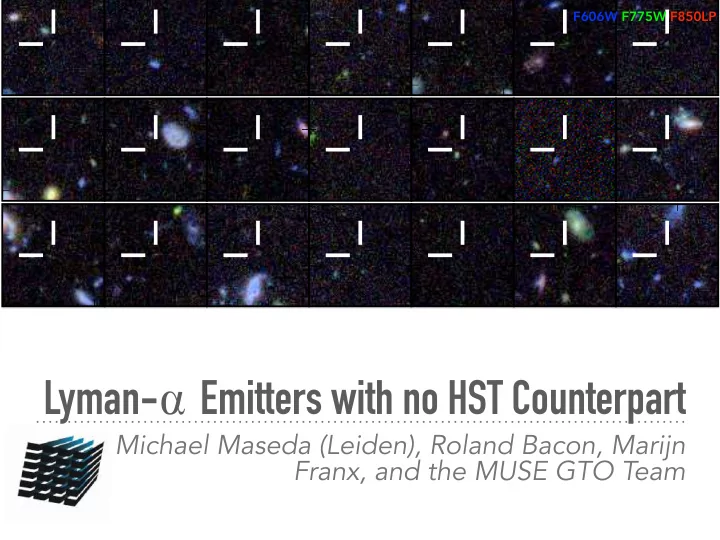

F606W F775W F850LP Lyman- ⍺ Emitters with no HST Counterpart Michael Maseda (Leiden), Roland Bacon, Marijn Franx, and the MUSE GTO Team
HOW WE GOT HERE ➤ MUSE is fantastic, because before we had to do things like this: Rauch+08 (92h FORS2)
HOW WE GOT HERE ➤ Bacon+15:
HOW WE GOT HERE ➤ Bacon+17: 72 “HST-undetected” LAEs in the UDF
HOW WE GOT HERE ➤ Maseda+18: 155 “high-EW” LAEs in the UDF
HOW WE GOT HERE ➤ Maseda+18: 155 “high-EW” LAEs in the UDF
WHY ARE THESE SOURCES POTENTIALLY INTERESTING? ➤ Plausibly high-EW LAEs (> 200 Å) ➤ Can only occur with young ages (< 10 Myr), very low metallicities, and/or top-heavy IMFs Hashimoto+17a
SPECTRAL STACKS ➤ Using correction from z Ly α to z sys using FWHM Ly α (Verhamme+ submitted) (Preliminary)
PHOTOMETRIC STACKS ➤ Blue continuum slopes ➤ M UV ~ -15 ➤ Effect of Ly- ⍺ visible
PHOTOMETRIC STACKS ➤ Blue continuum slopes ➤ M UV ~ -15 ➤ Effect of Ly- ⍺ visible
PHOTOMETRIC STACKS ➤ Blue continuum slopes ➤ M UV ~ -15 ➤ Effect of Ly- ⍺ visible β λ rest (Å)
DETERMINATION OF EW ➤ m UV from stacks for a given object (otherwise limit) ➤ 휷 from stacks in redshift bin
IS THIS EXPECTED? ➤ Based on an EW distribution (Hashimoto+17b) and a UV luminosity function (Bouwens+15), can predict fraction of LAEs that are below a detection limit
IS THIS EXPECTED? ➤ Based on an EW distribution (Hashimoto+17b) and a UV luminosity function (Bouwens+15), can predict fraction of LAEs that are below a detection limit
IS THIS EXPECTED? ➤ Based on an EW distribution (Hashimoto+17b) and a UV luminosity function (Bouwens+15), can predict fraction of LAEs that are below a detection limit
IS THIS EXPECTED? ➤ Based on an EW distribution (Hashimoto+17b) and a UV luminosity function (Bouwens+15), can predict fraction of LAEs that are below a detection limit Force EW < 240 Å
IS THIS EXPECTED? ➤ Based on an EW distribution (Hashimoto+17b) and a UV luminosity function (Bouwens+15), can predict fraction of LAEs that are below a detection limit
IS THIS EXPECTED? It’s hard to distinguish between these models, but undetected sources are expected
CONCLUSION AND OUTLOOK ➤ More than 150 high-EW LAEs in the UDF ➤ M UV as faint as -15 ➤ Blue ( β ~ -2) UV continuum slopes ➤ They appear to be an extension of the known LAE population ➤ More work (JWST?) will be required to fully characterize them ! ����������� !
Recommend
More recommend